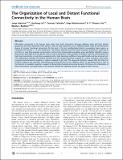| dc.contributor.author | Sepulcre, Jorge | |
| dc.contributor.author | Liu, Hesheng | |
| dc.contributor.author | Talukdar, Tanveer | |
| dc.contributor.author | Martincorena, Iñigo | |
| dc.contributor.author | Yeo, Boon Thye Thomas | |
| dc.contributor.author | Buckner, Randy Lee | |
| dc.date.accessioned | 2010-10-06T17:58:13Z | |
| dc.date.issued | 2010 | |
| dc.identifier.citation | Sepulcre, Jorge, Hesheng Liu, Tanveer Talukdar, Iñigo Martincorena, B. T. Thomas Yeo, and Randy L. Buckner. 2010. The Organization of Local and Distant Functional Connectivity in the Human Brain. PLoS Computational Biology 6(6): e1000808. | en_US |
| dc.identifier.issn | 1553-734X | en_US |
| dc.identifier.uri | http://nrs.harvard.edu/urn-3:HUL.InstRepos:4459991 | |
| dc.description.abstract | Information processing in the human brain arises from both interactions between adjacent areas and from distant projections that form distributed brain systems. Here we map interactions across different spatial scales by estimating the degree of intrinsic functional connectivity for the local (≤14 mm) neighborhood directly surrounding brain regions as contrasted with distant (>14 mm) interactions. The balance between local and distant functional interactions measured at rest forms a map that separates sensorimotor cortices from heteromodal association areas and further identifies regions that possess both high local and distant cortical-cortical interactions. Map estimates of network measures demonstrate that high local connectivity is most often associated with a high clustering coefficient, long path length, and low physical cost. Task performance changed the balance between local and distant functional coupling in a subset of regions, particularly, increasing local functional coupling in regions engaged by the task. The observed properties suggest that the brain has evolved a balance that optimizes information-processing efficiency across different classes of specialized areas as well as mechanisms to modulate coupling in support of dynamically changing processing demands. We discuss the implications of these observations and applications of the present method for exploring normal and atypical brain function. | en_US |
| dc.description.sponsorship | Psychology | en_US |
| dc.language.iso | en_US | en_US |
| dc.publisher | Public Library of Science | en_US |
| dc.relation.isversionof | doi:10.1371/journal.pcbi.1000808 | en_US |
| dc.relation.hasversion | http://www.ncbi.nlm.nih.gov/pmc/articles/PMC2883589/pdf/ | en_US |
| dash.license | OAP | |
| dc.subject | computational biology | en_US |
| dc.subject | computational neuroscience | en_US |
| dc.subject | neurological disorders | en_US |
| dc.subject | cognitive neurology and dementia | en_US |
| dc.subject | neuroimaging | en_US |
| dc.subject | neuropsychiatric disorders | en_US |
| dc.subject | neuroscience | en_US |
| dc.subject | cognitive neuroscience | en_US |
| dc.subject | theoretical neuroscience | en_US |
| dc.subject | psychology | en_US |
| dc.title | The Organization of Local and Distant Functional Connectivity in the Human Brain | en_US |
| dc.type | Journal Article | en_US |
| dc.description.version | Version of Record | en_US |
| dc.relation.journal | PLoS Computational Biology | en_US |
| dash.depositing.author | Buckner, Randy Lee | |
| dc.date.available | 2010-10-06T17:58:13Z | |
| dc.identifier.doi | 10.1371/journal.pcbi.1000808 | * |
| dash.contributor.affiliated | Liu, Hesheng | |
| dash.contributor.affiliated | Yeo, Boon Thye Thomas | |
| dash.contributor.affiliated | Buckner, Randy | |


